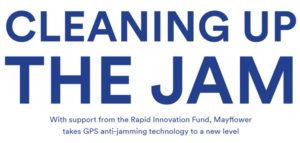CLEANING UP THE JAM

Established by the U.S. Department of Defense (DoD) in the late 1970s for military use, the Global Positioning System (GPS) is a satellite-based navigation system designed to function in any weather, anywhere in the world, at any time of day. Made available to civilians in the 1980s, there are currently more than 30 dedicated, GPS satellites circling 12,000 miles above the Earth, transmitting signals that allow millions of GPS devices to calculate their locations by measuring the distance to each satellite. While the U.S. controlled GPS is ubiquitous in much of the world, other similar systems also exist. Russia has its Global Navigation Satellite System (GLONASS), Europe recently launched Galileo, and China has BeiDou. Japan and India have also introduced their own regional systems.
GPS is most commonly used as a navigational tool, but there are any number of other uses as well, from agriculture and manufacturing to property surveys and self-driving cars. These days, it’s not much of a stretch to say that the global financial and communications systems both rely on GPS. And that’s also true of American military operations around the globe. Troop movements, missile defense, and reconnaissance all need GPS in order to properly function. With every technological strength, however, comes a vulnerability. It’s not especially difficult to imagine the catastrophe that would come as the result of a global GPS systems failure. And in terms of warfighter support, we’ve already seen the effect of GPS interference, or “jamming.”
During Operation Iraqi Freedom in 2003, some reports estimated that at least 80 percent of U.S. weapons were directed via satellite. GPS-guided munitions included Tomahawks, JDAMs (joint direct attack munitions), and the EGBU-27 (Enhanced Guided Bomb Unit-27, which linked GPS with laser guidance and inertial navigation). In the first confirmed use of GPS-jamming equipment, Iraqi forces then attempted to disrupt reception of the relatively weak GPS signal, using equipment reportedly imported from Russia. Although these attempts were unsuccessful (after US forces destroyed the six jammers), diverting “smart” bombs by jamming GPS signals can often cause unintended civilian casualties. Since that Second Gulf War, it has been reported that Russia, China, and North Korea have all jammed GPS signals in order to disrupt foreign military exercises, protect assets from attack, prevent surveillance, and interfere with industrial activity.
According to Dr. Triveni Upadhyay, founder and chairman of the Bedford, Massachusetts-based Mayflower Communications, “the problem has been out there for a long time. By design, GPS signals are very weak. So long as there is no interference, they work. But it has always been known that, given the opportunity, bad actors would jam the system. We are in the business of developing technology to prepare for that inevitability.”
When the need became urgent, Mayflower was well-positioned to respond. Since 1996, the company had been developing its “Small Affordable Anti-Jam GPS Antenna (SAAGA)” and follow-on anti-jam improvements, with funding from the DoD’s Small Business Innovation Research (SBIR) Program. Joseph P. Thomas, Mayflower’s Director of Government Programs, said, “In 2007, the Air Force, Navy, and Army jointly released a broad agency announcement seeking companies capable of developing a next-generation GPS anti-jam system that would meet three criteria: provide simultaneous protection on both the civilian and military signals; mitigate rotor blade reflection effects (rotatory aircraft blades deflect jammer signals at different angles, and most GPS anti-jam systems cannot adapt quickly enough to react); and reduce size, weight, and power requirements (SWaP).”
Mayflower responded by developing the Small Antenna System (SAS). Intended for the Army Joint Precision Air Landing System program, SAS was Mayflower’s first high-performance GPS anti-jam product designed to counter rotor-blade modulation effects, and was the only GPS AJ system at that time to do so effectively.
The Navy, having witnessed SAS’s successful development firsthand, turned to Mayflower for a similar solution for submarine platforms. They awarded the company a sole-source follow-on contract to build SAGE—the Submarine Anti-Jam GPS Enhancement. William LeComte, Mayflower’s Director of Anti-Jam Technology and Product Group, recounted how SAGE’s “high performance, low SWaP, and cost-effective antenna system will enable the U.S. Navy submarine fleet to safely operate in GPS contested or denied environments.”
SAGE’s success led the DoD to contract with Mayflower in 2014 under the Rapid Innovation Fund (RIF) to make SAGE non-platform specific so that it could serve ground vehicles, fixed wing aircraft, rotary wing aircraft, UAVs, and small ships, as well as submarines.
The Rapid Innovation Fund, established in 2011 by the National Defense Authorization Act (NDAA) is a competitive, merit-based program that accelerates the fielding of innovative technologies into military systems. The Mayflower technology enabled by the RIF contract is called MAGNA—the Multi-Platform Anti-Jam GPS Navigation Antenna.
A critical design element in all of Mayflower’s anti-jamming solutions is their backward compatibility, which enables the replacement of an existing antenna without the need for putting additional holes in the platform. The MAGNA F (Federated) is a two-piece design while the MAGNA I (Integrated) has the electronics integrated into a single package with similar performance.
A member of the U.S. Special Operations Command (SOCOM) reported to Mayflower in 2019 that “things are going well with the MAGNA-F on the platform that has been converted. I see reports almost daily from the success of that unit since our team had the ability to switch from regular GPS antenna to MAGNA-F antenna. We absolutely need these for our mission. If you thought I was a pain before about getting these items as quick as possible … now I’m going to be asking twice as often!”
Reflecting on the impact of his company’s contribution, Upadhyay said, “It is big, in the sense that one area of vulnerability is gone. It is like a cat and mouse game. You have to learn to live with the jamming. But we don’t want it to be easy for them to jam us. You don’t leave your house open for people to burgle. Before, our door was unlocked. Now we have put a lock on the door. At the highest level, we can now do missions in unfriendly territory without endangering soldiers’ lives. If you don’t have GPS, you don’t fly. With our solution on the platform, our troops can now reach the target. We have provided a good solution in the near term, but we are constantly improving because there will always be a new threat coming. We improve our technology, they improve theirs, then we need to step up again. As long as there is a disincentive for them to jam, we win.”
Modernization Priority: Networked Command, Control, and Communications (C3)
RIF Award: 2013 Navy SPAWAR: “Multi-platform Anti-jam GPS Navigation Antenna” (N00039-14-C-0104) – SBIR Phase III
Enabling SBIR: Army topic A95-023 “Small Affordable Anti-Jam GPS Antenna (SAAGA)” (Phase II contract: DAAB07-98-C-A501)
Approved for release bu the US Navy PAO: SR-2022-072
